
苏州大学医学部药学院授课教案 授课教师:应征 授课日期:2021年3月2日 课程名称 Molecular cell biology(英文) 所属学科 药学 Molecular Cell Biology,Lodish、Berk等编 本科三年级第 教材名称 授课年级 著,第八版 一学期 授课章节 1.Cell structure and function 授课时间 150分钟 一、教学目标:含知识目标、技能(能力)目标 1.知识目标: (1)Understand the basic concept of molecular cell biology. (2)Understand the relationship cell biology and molecular biology. (3)Understand the morphology of intracellular organelles. (4)Understand the basic functions of intracellular organelles. 2.技能(能力)目标: (1)Learn basic English terms in cell biology (2)Improve the skills in listening and speaking of English in cell biology 二、授课内容(依据教学大纲)及时间分配 Lecture 1: (1)Brief review of the living organisms(10 min) (2)the common ancestral cell for all living organisms(5 min) (3)The size of virus,prokaryotic and eukaryotic cells(5 min) (4)The general location and forms of the genome in cells and viruses(15 min) (5)The differences between virus,prokaryotic and eukaryotic cells(15 min) Lecture 2: (6)A virus is not a living organism (10 min) (7)A virus is a microscopic particle that can infect the cells(10 min) (8)The structure of naked virus and enveloped virus(15 min)
苏州大学医学部药学院授课教案 授课教师:应征 授课日期:2021 年 3 月 2 日 课程名称 Molecular cell biology(英文) 所属学科 药学 教材名称 Molecular Cell Biology,Lodish、Berk 等编 著,第八版 授课年级 本科三年级第 一学期 授课章节 1. Cell structure and function 授课时间 150 分钟 一、教学目标:含知识目标、技能(能力)目标 1.知识目标: (1) Understand the basic concept of molecular cell biology. (2) Understand the relationship cell biology and molecular biology. (3) Understand the morphology of intracellular organelles. (4) Understand the basic functions of intracellular organelles. 2. 技能(能力)目标: (1) Learn basic English terms in cell biology (2) Improve the skills in listening and speaking of English in cell biology 二、授课内容(依据教学大纲)及时间分配 Lecture 1: (1) Brief review of the living organisms (10 min) (2) the common ancestral cell for all living organisms (5 min) (3) The size of virus, prokaryotic and eukaryotic cells (5 min) (4) The general location and forms of the genome in cells and viruses (15 min) (5) The differences between virus, prokaryotic and eukaryotic cells (15 min) Lecture 2: (6) A virus is not a living organism (10 min) (7) A virus is a microscopic particle that can infect the cells (10 min) (8) The structure of naked virus and enveloped virus (15 min)
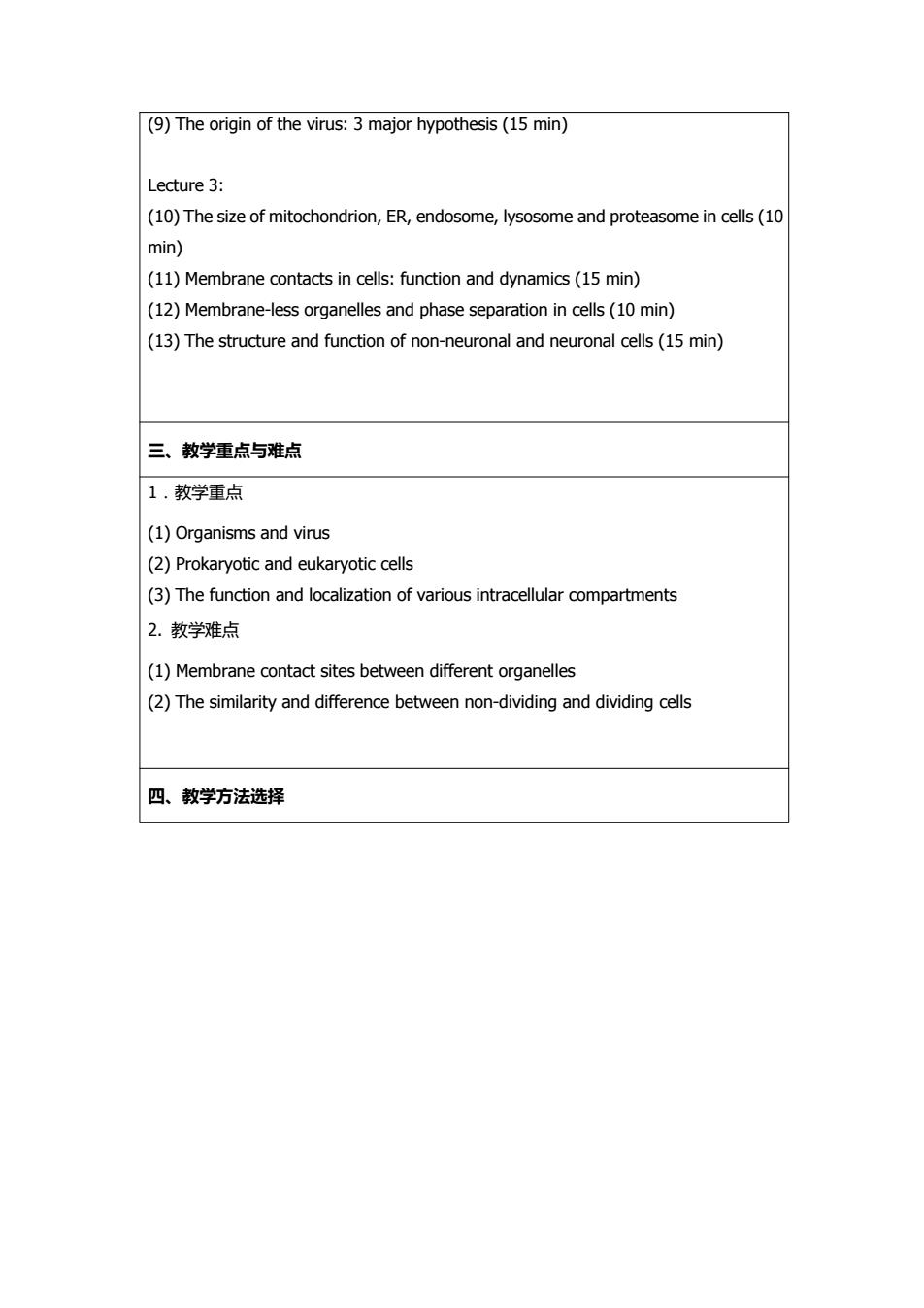
(9)The origin of the virus:3 major hypothesis(15 min) Lecture 3: (10)The size of mitochondrion,ER,endosome,lysosome and proteasome in cells(10 min) (11)Membrane contacts in cells:function and dynamics(15 min) (12)Membrane-less organelles and phase separation in cells(10 min) (13)The structure and function of non-neuronal and neuronal cells(15 min) 三、教学重点与难点 1.教学重点 (1)Organisms and virus (2)Prokaryotic and eukaryotic cells (3)The function and localization of various intracellular compartments 2.教学难点 (1)Membrane contact sites between different organelles (2)The similarity and difference between non-dividing and dividing cells 四、教学方法选择
(9) The origin of the virus: 3 major hypothesis (15 min) Lecture 3: (10) The size of mitochondrion, ER, endosome, lysosome and proteasome in cells (10 min) (11) Membrane contacts in cells: function and dynamics (15 min) (12) Membrane-less organelles and phase separation in cells (10 min) (13) The structure and function of non-neuronal and neuronal cells (15 min) 三、教学重点与难点 1.教学重点 (1) Organisms and virus (2) Prokaryotic and eukaryotic cells (3) The function and localization of various intracellular compartments 2. 教学难点 (1) Membrane contact sites between different organelles (2) The similarity and difference between non-dividing and dividing cells 四、教学方法选择
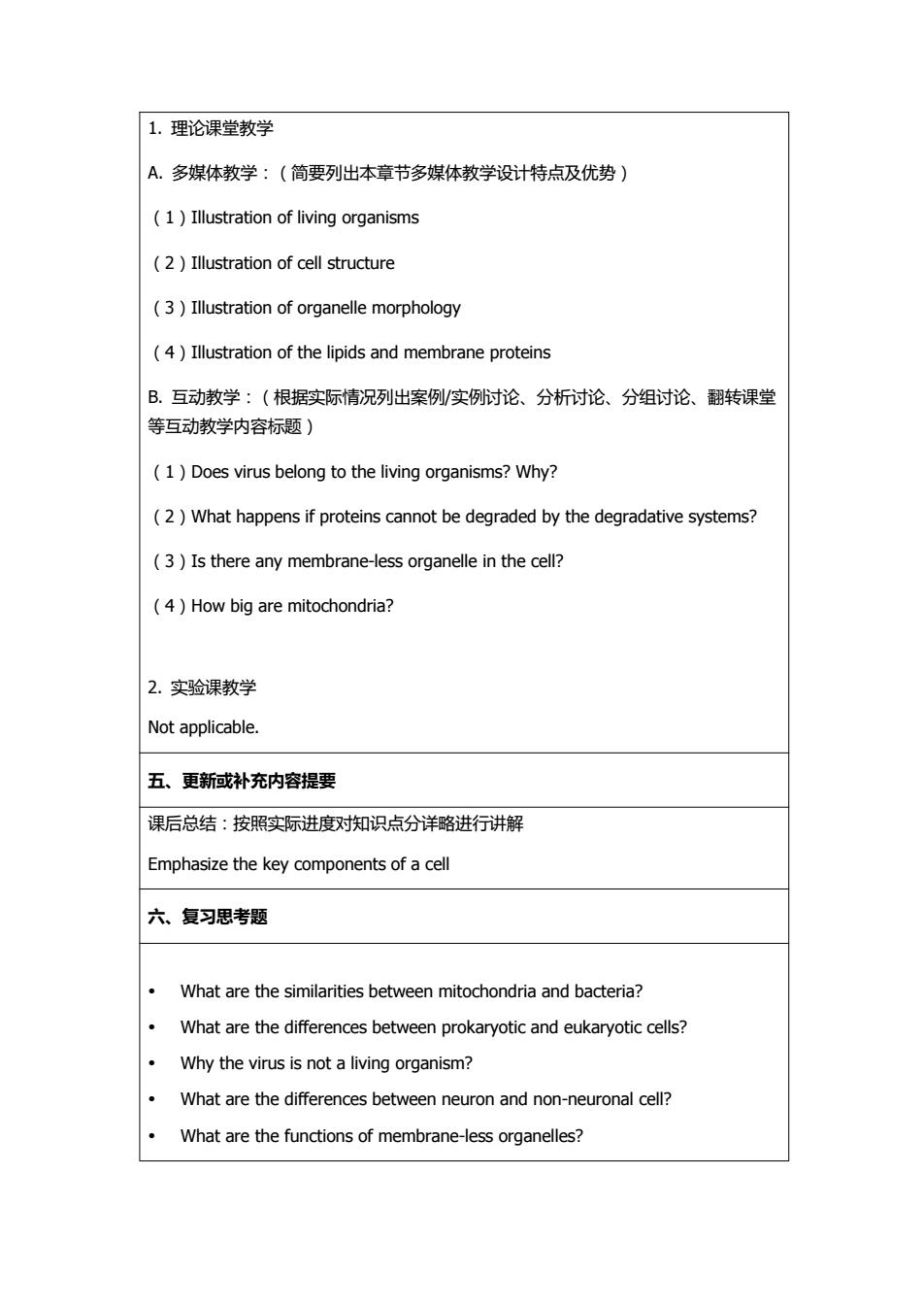
1.理论课堂教学 A.多媒体教学:(简要列出本章节多媒体教学设计特点及优势) (1)Illustration of living organisms (2)Illustration of cell structure (3 )Illustration of organelle morphology (4)Illustration of the lipids and membrane proteins B.互动教学:(根据实际情况列出案例/实例讨论、分析讨论、分组讨论、翻转课堂 等互动教学内容标题) (1 Does virus belong to the living organisms?Why? (2)What happens if proteins cannot be degraded by the degradative systems? (3)Is there any membrane-less organelle in the cell? (4)How big are mitochondria? 2.实验课教学 Not applicable. 五、更新或补充内容提要 课后总结:按照实际进度对知识点分详略进行讲解 Emphasize the key components of a cell 六、复习思考题 What are the similarities between mitochondria and bacteria? What are the differences between prokaryotic and eukaryotic cells? Why the virus is not a living organism? What are the differences between neuron and non-neuronal cell? What are the functions of membrane-less organelles?
1. 理论课堂教学 A. 多媒体教学:(简要列出本章节多媒体教学设计特点及优势) (1)Illustration of living organisms (2)Illustration of cell structure (3)Illustration of organelle morphology (4)Illustration of the lipids and membrane proteins B. 互动教学:(根据实际情况列出案例/实例讨论、分析讨论、分组讨论、翻转课堂 等互动教学内容标题) (1)Does virus belong to the living organisms? Why? (2)What happens if proteins cannot be degraded by the degradative systems? (3)Is there any membrane-less organelle in the cell? (4)How big are mitochondria? 2. 实验课教学 Not applicable. 五、更新或补充内容提要 课后总结:按照实际进度对知识点分详略进行讲解 Emphasize the key components of a cell 六、复习思考题 What are the similarities between mitochondria and bacteria? What are the differences between prokaryotic and eukaryotic cells? Why the virus is not a living organism? What are the differences between neuron and non-neuronal cell? What are the functions of membrane-less organelles?

七、学习资源、课外自主学习参考 (可以列出供学生进一步学习、拓展本章节内容的网站、著作、期刊的名称及内容等) Molecular Biology of the Cell,Alberts等编著,第六版,2014年出版,Garland Science Molecular Biology::Principles and Practice,.Michael Cox等编著,第二版,20l5 年出版,W.H.Freeman and Company Molecular Biology,,Robert Weaver,第五版,2012年出版,McGraw-Hil
七、学习资源、课外自主学习参考 (可以列出供学生进一步学习、拓展本章节内容的网站、著作、期刊的名称及内容等) Molecular Biology of the Cell,Alberts 等编著,第六版,2014 年出版,Garland Science Molecular Biology: Principles and Practice, Michael Cox 等编著, 第二版,2015 年出版,W. H. Freeman and Company Molecular Biology, Robert Weaver, 第五版,2012 年出版,McGraw-Hill
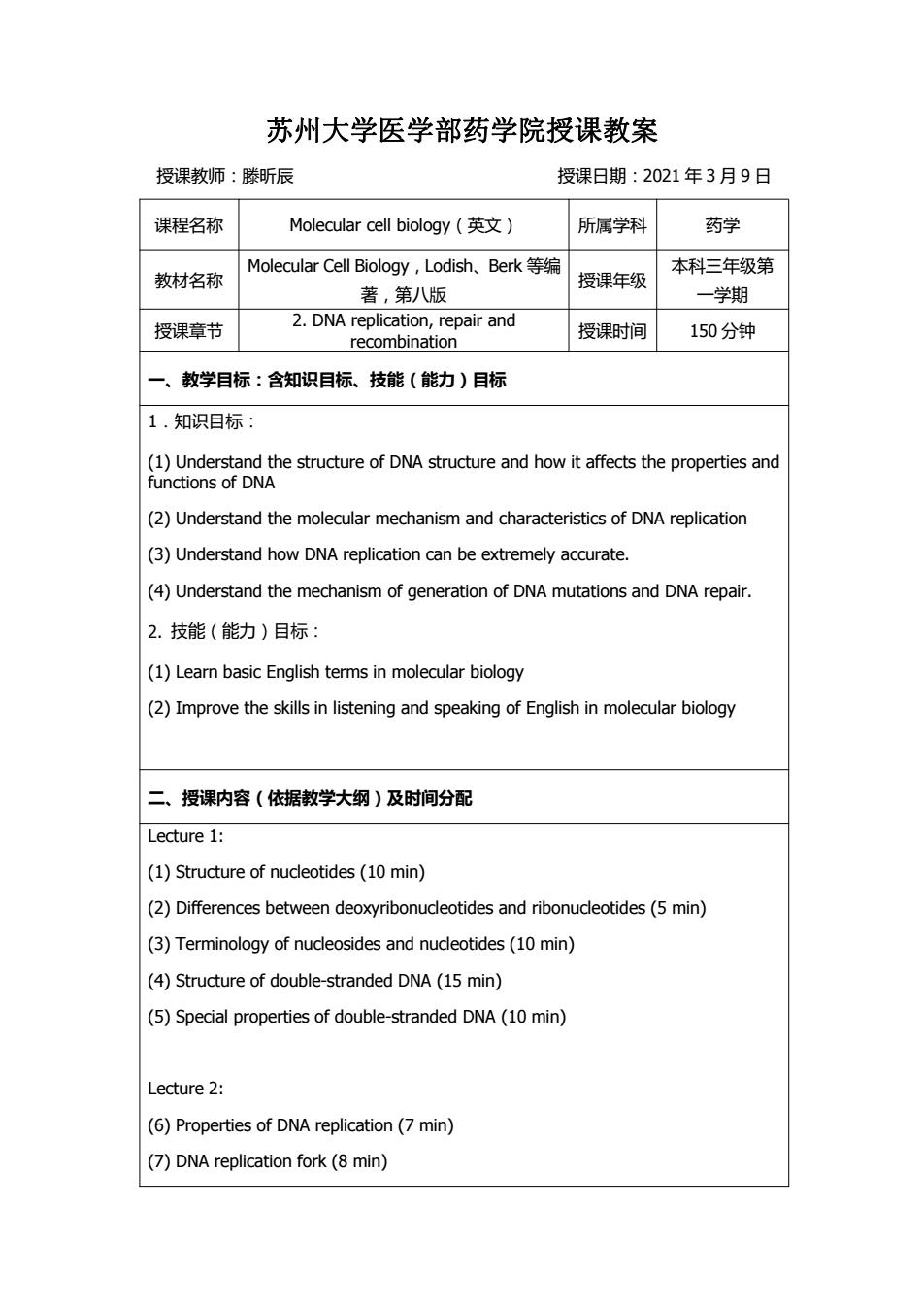
苏州大学医学部药学院授课教案 授课教师:滕昕辰 授课日期:2021年3月9日 课程名称 Molecular cell biology(英文) 所属学科 药学 Molecular Cell Biology,Lodish、Berk等编 本科三年级第 教材名称 著,第八版 授课年级 一学期 授课章节 2.DNA replication,repair and recombination 授课时间 150分钟 一、教学目标:含知识目标、技能(能力)目标 1.知识目标: (1)Understand the structure of DNA structure and how it affects the properties and functions of DNA (2)Understand the molecular mechanism and characteristics of DNA replication (3)Understand how DNA replication can be extremely accurate. (4)Understand the mechanism of generation of DNA mutations and DNA repair. 2.技能(能力)目标: (1)Learn basic English terms in molecular biology (2)Improve the skills in listening and speaking of English in molecular biology 二、授课内容(依据教学大纲)及时间分配 Lecture 1: (1)Structure of nucleotides(10 min) (2)Differences between deoxyribonucleotides and ribonucleotides(5 min) (3)Terminology of nucleosides and nucleotides(10 min) (4)Structure of double-stranded DNA(15 min) (5)Special properties of double-stranded DNA(10 min) Lecture 2: (6)Properties of DNA replication(7 min) (7)DNA replication fork(8 min)
苏州大学医学部药学院授课教案 授课教师:滕昕辰 授课日期:2021 年 3 月 9 日 课程名称 Molecular cell biology(英文) 所属学科 药学 教材名称 Molecular Cell Biology,Lodish、Berk 等编 著,第八版 授课年级 本科三年级第 一学期 授课章节 2. DNA replication, repair and recombination 授课时间 150 分钟 一、教学目标:含知识目标、技能(能力)目标 1.知识目标: (1) Understand the structure of DNA structure and how it affects the properties and functions of DNA (2) Understand the molecular mechanism and characteristics of DNA replication (3) Understand how DNA replication can be extremely accurate. (4) Understand the mechanism of generation of DNA mutations and DNA repair. 2. 技能(能力)目标: (1) Learn basic English terms in molecular biology (2) Improve the skills in listening and speaking of English in molecular biology 二、授课内容(依据教学大纲)及时间分配 Lecture 1: (1) Structure of nucleotides (10 min) (2) Differences between deoxyribonucleotides and ribonucleotides (5 min) (3) Terminology of nucleosides and nucleotides (10 min) (4) Structure of double-stranded DNA (15 min) (5) Special properties of double-stranded DNA (10 min) Lecture 2: (6) Properties of DNA replication (7 min) (7) DNA replication fork (8 min)
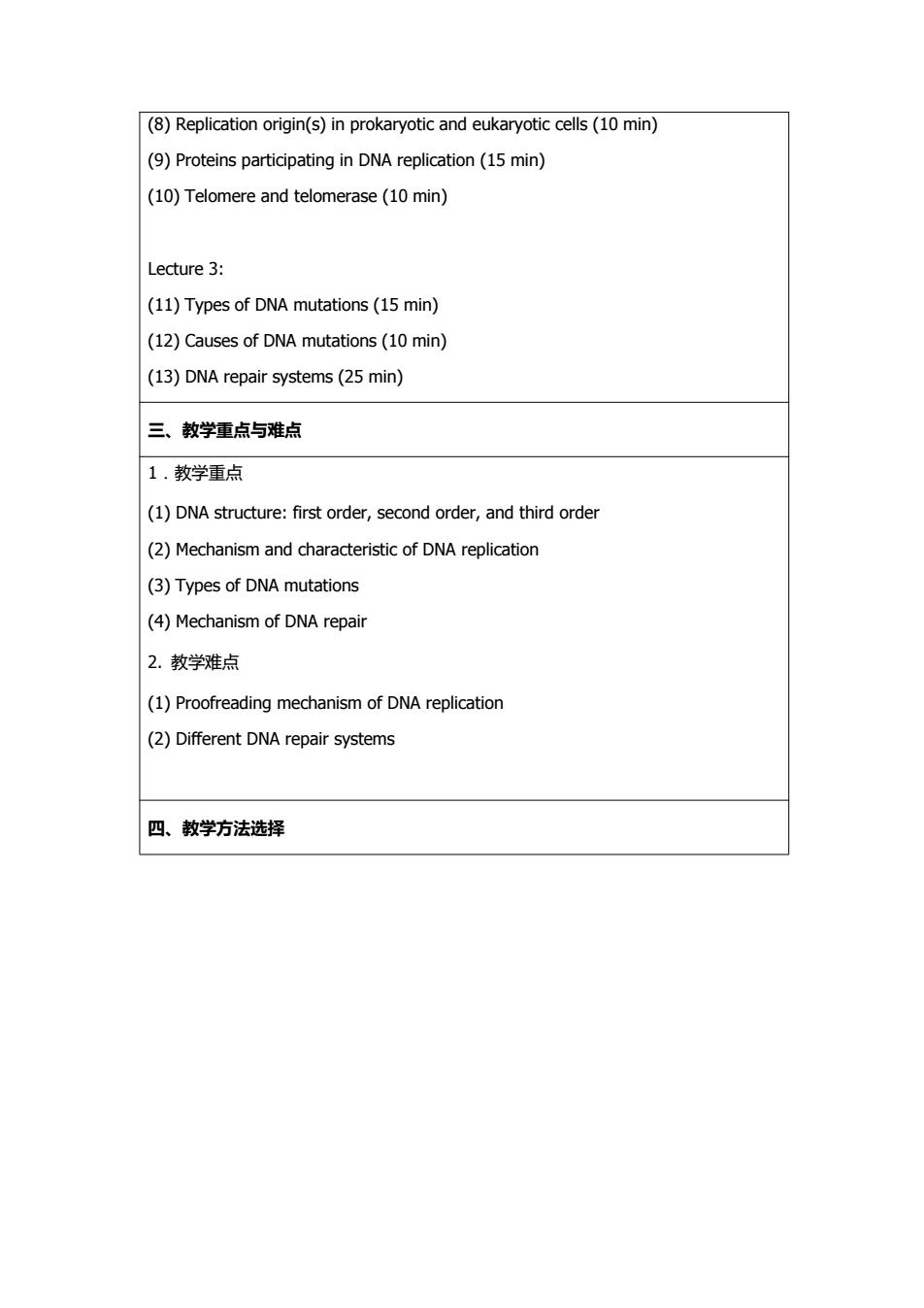
(8)Replication origin(s)in prokaryotic and eukaryotic cells(10 min) (9)Proteins participating in DNA replication(15 min) (10)Telomere and telomerase(10 min) Lecture 3: (11)Types of DNA mutations(15 min) (12)Causes of DNA mutations(10 min) (13)DNA repair systems(25 min) 三、教学重点与难点 1.教学重点 (1)DNA structure:first order,second order,and third order (2)Mechanism and characteristic of DNA replication (3)Types of DNA mutations (4)Mechanism of DNA repair 2.教学难点 (1)Proofreading mechanism of DNA replication (2)Different DNA repair systems 四、教学方法选择
(8) Replication origin(s) in prokaryotic and eukaryotic cells (10 min) (9) Proteins participating in DNA replication (15 min) (10) Telomere and telomerase (10 min) Lecture 3: (11) Types of DNA mutations (15 min) (12) Causes of DNA mutations (10 min) (13) DNA repair systems (25 min) 三、教学重点与难点 1.教学重点 (1) DNA structure: first order, second order, and third order (2) Mechanism and characteristic of DNA replication (3) Types of DNA mutations (4) Mechanism of DNA repair 2. 教学难点 (1) Proofreading mechanism of DNA replication (2) Different DNA repair systems 四、教学方法选择
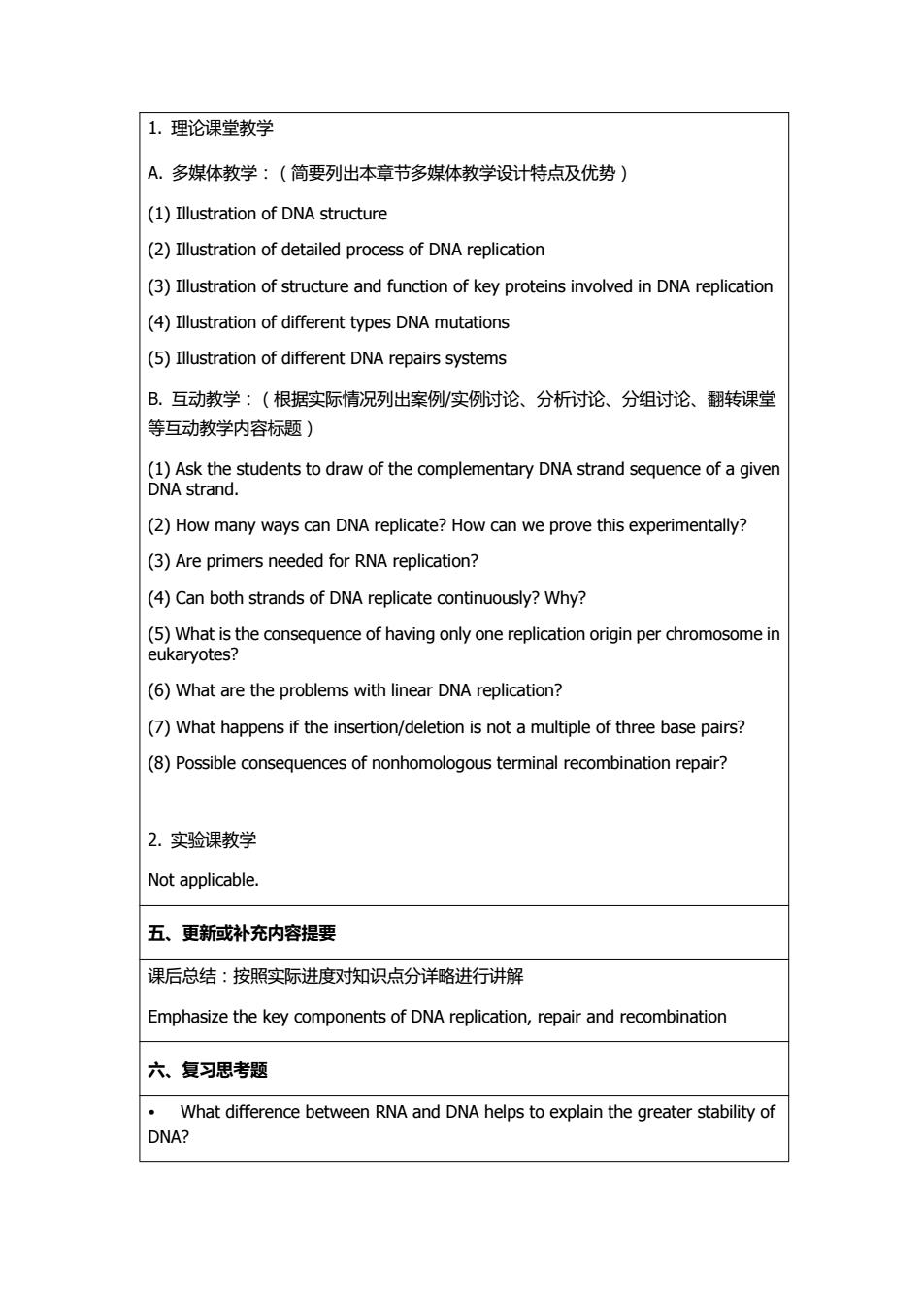
1.理论课堂教学 A.多媒体教学:(简要列出本章节多媒体教学设计特点及优势) (1)Illustration of DNA structure (2)Illustration of detailed process of DNA replication (3)Illustration of structure and function of key proteins involved in DNA replication (4)Illustration of different types DNA mutations (5)Illustration of different DNA repairs systems B.互动教学:(根据实际情况列出案例/实例讨论、分析讨论、分组讨论、翻转课堂 等互动教学内容标题) (1)Ask the students to draw of the complementary DNA strand sequence of a given DNA strand. (2)How many ways can DNA replicate?How can we prove this experimentally? (3)Are primers needed for RNA replication? (4)Can both strands of DNA replicate continuously?Why? (5)What is the consequence of having only one replication origin per chromosome in eukaryotes? (6)What are the problems with linear DNA replication? (7)What happens if the insertion/deletion is not a multiple of three base pairs? (8)Possible consequences of nonhomologous terminal recombination repair? 2.实验课教学 Not applicable. 五、更新或补充内容提要 课后总结:按照实际进度对知识点分详略进行讲解 Emphasize the key components of DNA replication,repair and recombination 六、复习思考题 What difference between RNA and DNA helps to explain the greater stability of DNA?
1. 理论课堂教学 A. 多媒体教学:(简要列出本章节多媒体教学设计特点及优势) (1) Illustration of DNA structure (2) Illustration of detailed process of DNA replication (3) Illustration of structure and function of key proteins involved in DNA replication (4) Illustration of different types DNA mutations (5) Illustration of different DNA repairs systems B. 互动教学:(根据实际情况列出案例/实例讨论、分析讨论、分组讨论、翻转课堂 等互动教学内容标题) (1) Ask the students to draw of the complementary DNA strand sequence of a given DNA strand. (2) How many ways can DNA replicate? How can we prove this experimentally? (3) Are primers needed for RNA replication? (4) Can both strands of DNA replicate continuously? Why? (5) What is the consequence of having only one replication origin per chromosome in eukaryotes? (6) What are the problems with linear DNA replication? (7) What happens if the insertion/deletion is not a multiple of three base pairs? (8) Possible consequences of nonhomologous terminal recombination repair? 2. 实验课教学 Not applicable. 五、更新或补充内容提要 课后总结:按照实际进度对知识点分详略进行讲解 Emphasize the key components of DNA replication, repair and recombination 六、复习思考题 • What difference between RNA and DNA helps to explain the greater stability of DNA?
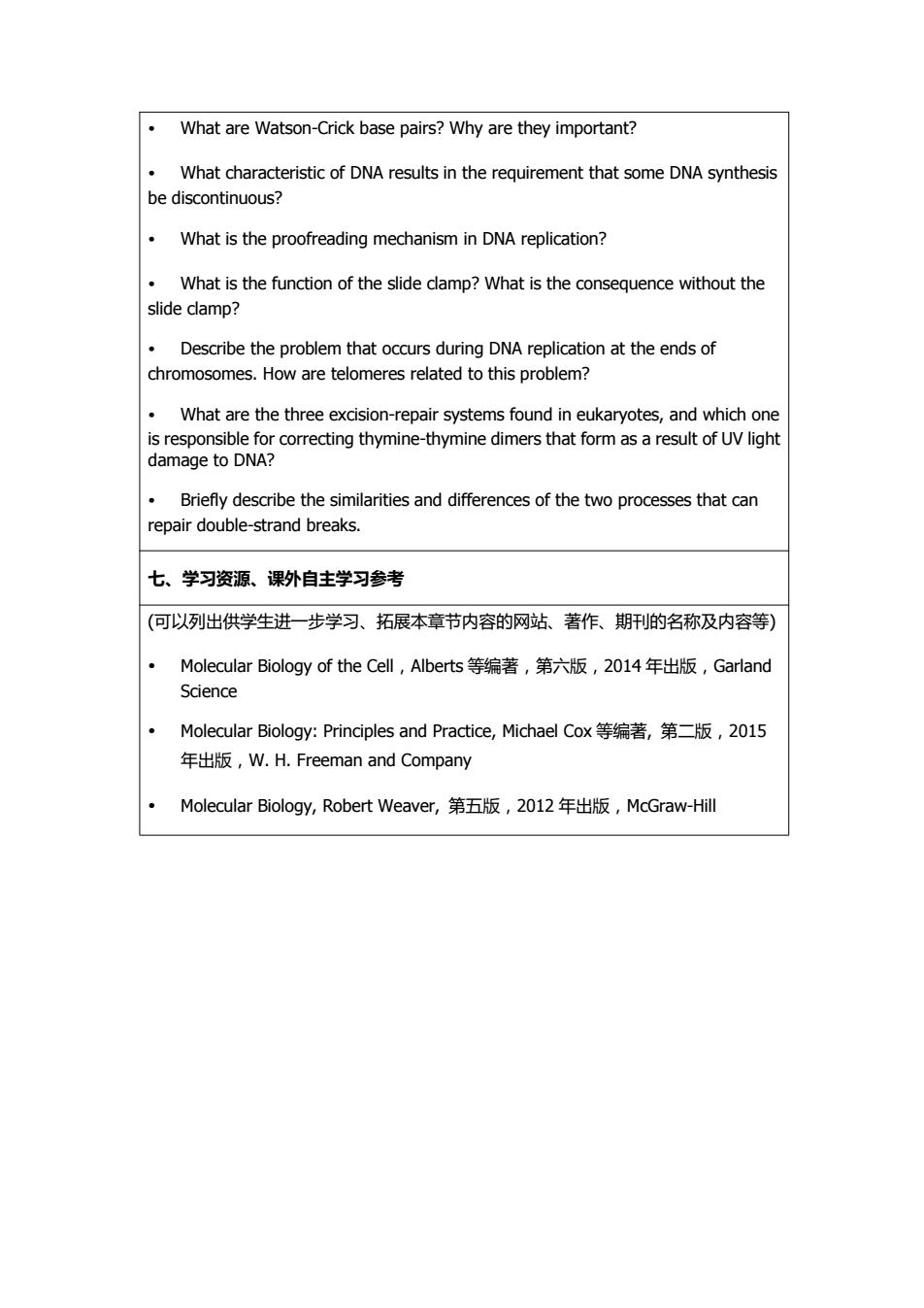
What are Watson-Crick base pairs?Why are they important? What characteristic of DNA results in the requirement that some DNA synthesis be discontinuous? What is the proofreading mechanism in DNA replication? What is the function of the slide clamp?What is the consequence without the slide clamp? Describe the problem that occurs during DNA replication at the ends of chromosomes.How are telomeres related to this problem? What are the three excision-repair systems found in eukaryotes,and which one is responsible for correcting thymine-thymine dimers that form as a result of UV light damage to DNA? Briefly describe the similarities and differences of the two processes that can repair double-strand breaks. 七、学习资源、课外自主学习参考 (可以列出供学生进一步学习、拓展本章节内容的网站、著作、期刊的名称及内容等) Molecular Biology of the Cell,Alberts等编著,第六版,2014年出版,Garland Science Molecular Biology::Principles and Practice,Michael Cox等编著,第二版,2015 年出版,W.H.Freeman and Company Molecular Biology,,Robert Weaver,第五版,20l2年出版,McGraw-Hill
• What are Watson-Crick base pairs? Why are they important? • What characteristic of DNA results in the requirement that some DNA synthesis be discontinuous? • What is the proofreading mechanism in DNA replication? • What is the function of the slide clamp? What is the consequence without the slide clamp? • Describe the problem that occurs during DNA replication at the ends of chromosomes. How are telomeres related to this problem? • What are the three excision-repair systems found in eukaryotes, and which one is responsible for correcting thymine-thymine dimers that form as a result of UV light damage to DNA? • Briefly describe the similarities and differences of the two processes that can repair double-strand breaks. 七、学习资源、课外自主学习参考 (可以列出供学生进一步学习、拓展本章节内容的网站、著作、期刊的名称及内容等) Molecular Biology of the Cell,Alberts 等编著,第六版,2014 年出版,Garland Science Molecular Biology: Principles and Practice, Michael Cox 等编著, 第二版,2015 年出版,W. H. Freeman and Company Molecular Biology, Robert Weaver, 第五版,2012 年出版,McGraw-Hill
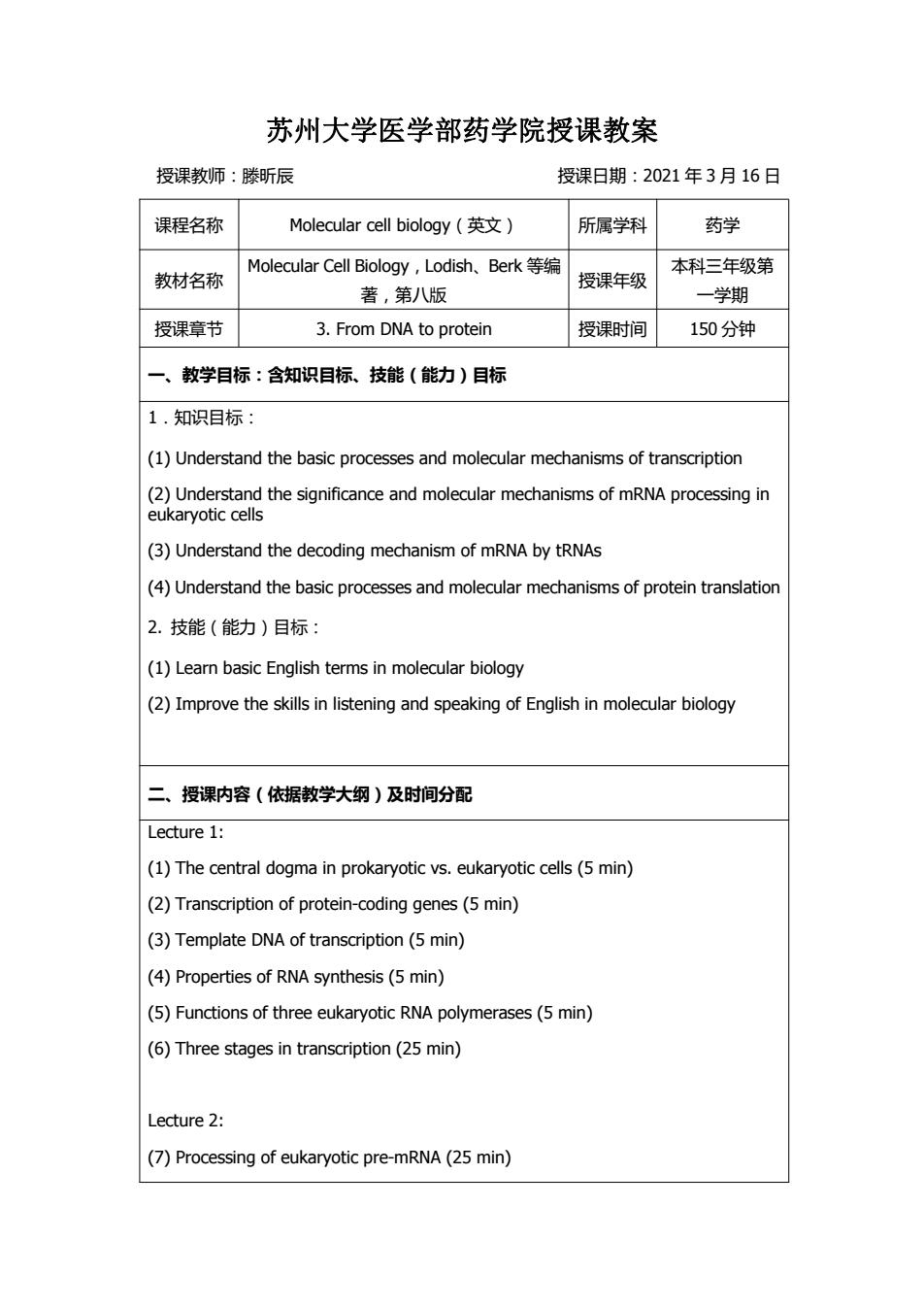
苏州大学医学部药学院授课教案 授课教师:滕昕辰 授课日期:2021年3月16日 课程名称 Molecular cell biology(英文) 所属学科 药学 Molecular Cell Biology,Lodish、Berk等编 本科三年级第 教材名称 授课年级 著,第八版 一学期 授课章节 3.From DNA to protein 授课时间 150分钟 一、教学目标:含知识目标、技能(能力)目标 1.知识目标: (1)Understand the basic processes and molecular mechanisms of transcription (2)Understand the significance and molecular mechanisms of mRNA processing in eukaryotic cells (3)Understand the decoding mechanism of mRNA by tRNAs (4)Understand the basic processes and molecular mechanisms of protein translation 2.技能(能力)目标: (1)Learn basic English terms in molecular biology (2)Improve the skills in listening and speaking of English in molecular biology 二、 授课内容(依据教学大纲)及时间分配 Lecture 1: (1)The central dogma in prokaryotic vs.eukaryotic cells(5 min) (2)Transcription of protein-coding genes(5 min) (3)Template DNA of transcription(5 min) (4)Properties of RNA synthesis(5 min) (5)Functions of three eukaryotic RNA polymerases(5 min) (6)Three stages in transcription(25 min) Lecture 2: (7)Processing of eukaryotic pre-mRNA(25 min)
苏州大学医学部药学院授课教案 授课教师:滕昕辰 授课日期:2021 年 3 月 16 日 课程名称 Molecular cell biology(英文) 所属学科 药学 教材名称 Molecular Cell Biology,Lodish、Berk 等编 著,第八版 授课年级 本科三年级第 一学期 授课章节 3. From DNA to protein 授课时间 150 分钟 一、教学目标:含知识目标、技能(能力)目标 1.知识目标: (1) Understand the basic processes and molecular mechanisms of transcription (2) Understand the significance and molecular mechanisms of mRNA processing in eukaryotic cells (3) Understand the decoding mechanism of mRNA by tRNAs (4) Understand the basic processes and molecular mechanisms of protein translation 2. 技能(能力)目标: (1) Learn basic English terms in molecular biology (2) Improve the skills in listening and speaking of English in molecular biology 二、授课内容(依据教学大纲)及时间分配 Lecture 1: (1) The central dogma in prokaryotic vs. eukaryotic cells (5 min) (2) Transcription of protein-coding genes (5 min) (3) Template DNA of transcription (5 min) (4) Properties of RNA synthesis (5 min) (5) Functions of three eukaryotic RNA polymerases (5 min) (6) Three stages in transcription (25 min) Lecture 2: (7) Processing of eukaryotic pre-mRNA (25 min)

(8)Three RNAs involved in translation:mRNA,tRNA,rRNA(5 min) (9)Messenger RNA carries information from DNA in a three-letter genetic code(5 min) (10)The folded structure of tRNA promotes its decoding functions(5 min) (11)Nonstandard base pairing between codons and anticodons(10 min) Lecture 3: (12)Function of aminoacyl-tRNA synthetases in decoding (15 min) (13)Structure of ribosomes:RNA components,A,P,E sites(10 min) (14)Stepwise synthesis of proteins on ribosomes(15 min) (15)GTPase-superfamily proteins function in several quality-control steps of translation (10 min) 三、教学重点与难点 1.教学重点 (1)Fundamental processes and molecular mechanisms of RNA transcription (2)Fundamental processes and molecular mechanisms of mRNA processing in eukaryotic cells (3)The decoding of mRNA by tRNAs (4)Structure and function of tRNA-aminoyl synthase (5)Molecular mechanisms of initiation,extension,and termination of translation 2.教学难点 (1)Sequence relationships of the template,coding strand and RNA transcripts (2)RNA transcription initiation and abortive initiation (3)Nonstandard base pairing between codons and anticodons (4)Mechanism and significance of proofreading function of aminoyl-tRNA synthase (5)Translocation of sites A,P,and E during protein translation (6)Function of GTP-binding proteins involved in protein translation 四、教学方法选择
(8) Three RNAs involved in translation: mRNA, tRNA, rRNA (5 min) (9) Messenger RNA carries information from DNA in a three-letter genetic code (5 min) (10) The folded structure of tRNA promotes its decoding functions (5 min) (11) Nonstandard base pairing between codons and anticodons (10 min) Lecture 3: (12) Function of aminoacyl-tRNA synthetases in decoding (15 min) (13) Structure of ribosomes: RNA components, A, P, E sites (10 min) (14) Stepwise synthesis of proteins on ribosomes (15 min) (15) GTPase-superfamily proteins function in several quality-control steps of translation (10 min) 三、教学重点与难点 1.教学重点 (1) Fundamental processes and molecular mechanisms of RNA transcription (2) Fundamental processes and molecular mechanisms of mRNA processing in eukaryotic cells (3) The decoding of mRNA by tRNAs (4) Structure and function of tRNA-aminoyl synthase (5) Molecular mechanisms of initiation, extension, and termination of translation 2. 教学难点 (1) Sequence relationships of the template, coding strand and RNA transcripts (2) RNA transcription initiation and abortive initiation (3) Nonstandard base pairing between codons and anticodons (4) Mechanism and significance of proofreading function of aminoyl-tRNA synthase (5) Translocation of sites A, P, and E during protein translation (6) Function of GTP-binding proteins involved in protein translation 四、教学方法选择